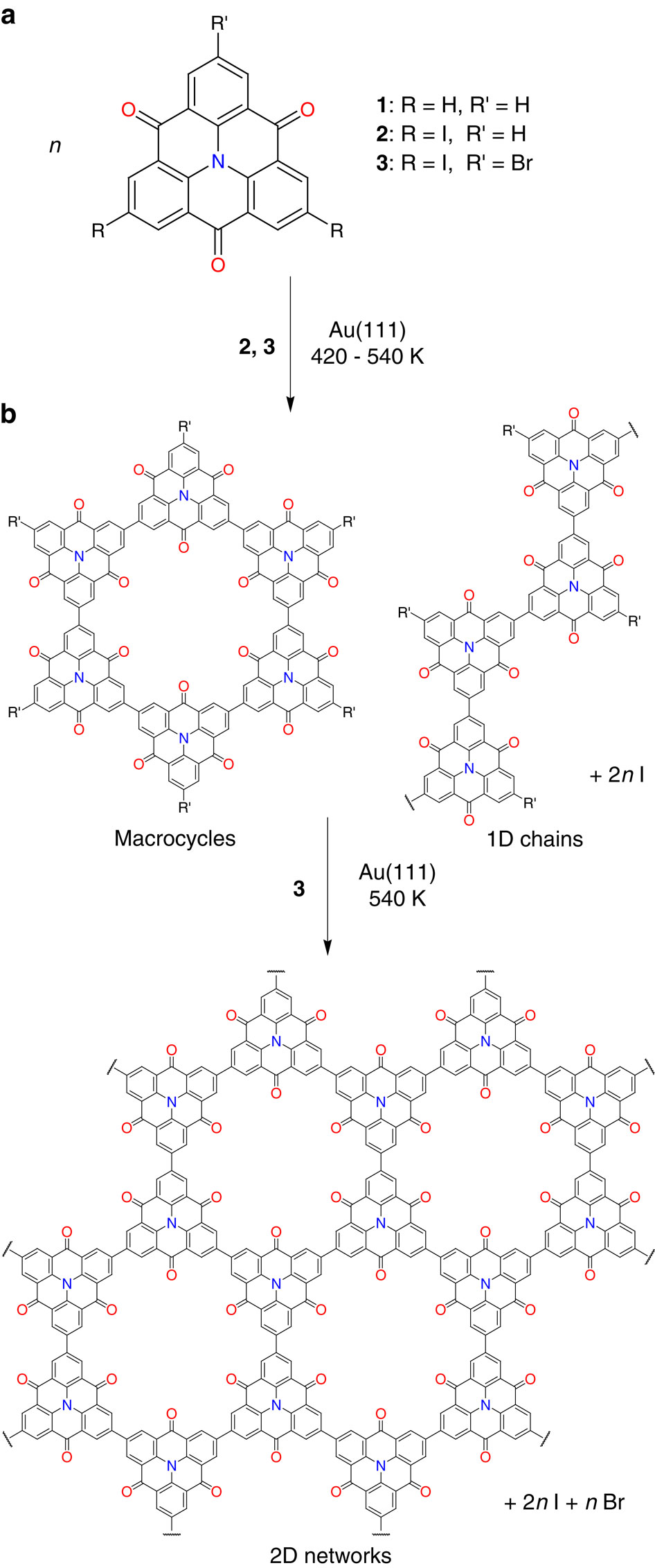当前位置:
X-MOL 学术
›
Nat. Commun.
›
论文详情
Our official English website, www.x-mol.net, welcomes your
feedback! (Note: you will need to create a separate account there.)
Hierarchical on-surface synthesis and electronic structure of carbonyl-functionalized one- and two-dimensional covalent nanoarchitectures.
Nature Communications ( IF 14.7 ) Pub Date : 2017-03-21 , DOI: 10.1038/ncomms14765 Christian Steiner 1 , Julian Gebhardt 2 , Maximilian Ammon 1 , Zechao Yang 1 , Alexander Heidenreich 3 , Natalie Hammer 3 , Andreas Görling 2 , Milan Kivala 3 , Sabine Maier 1
Nature Communications ( IF 14.7 ) Pub Date : 2017-03-21 , DOI: 10.1038/ncomms14765 Christian Steiner 1 , Julian Gebhardt 2 , Maximilian Ammon 1 , Zechao Yang 1 , Alexander Heidenreich 3 , Natalie Hammer 3 , Andreas Görling 2 , Milan Kivala 3 , Sabine Maier 1
Affiliation

|
The fabrication of nanostructures in a bottom-up approach from specific molecular precursors offers the opportunity to create tailored materials for applications in nanoelectronics. However, the formation of defect-free two-dimensional (2D) covalent networks remains a challenge, which makes it difficult to unveil their electronic structure. Here we report on the hierarchical on-surface synthesis of nearly defect-free 2D covalent architectures with carbonyl-functionalized pores on Au(111), which is investigated by low-temperature scanning tunnelling microscopy in combination with density functional theory calculations. The carbonyl-bridged triphenylamine precursors form six-membered macrocycles and one-dimensional (1D) chains as intermediates in an Ullmann-type coupling reaction that are subsequently interlinked to 2D networks. The electronic band gap is narrowed when going from the monomer to 1D and 2D surface-confined π-conjugated organic polymers comprising the same building block. The significant drop of the electronic gap from the monomer to the polymer confirms an efficient conjugation along the triphenylamine units within the nanostructures.
中文翻译:

羰基功能化一维和二维共价纳米结构的分层表面合成和电子结构。
利用特定分子前体以自下而上的方法制造纳米结构,为创建用于纳米电子学应用的定制材料提供了机会。然而,无缺陷二维(2D)共价网络的形成仍然是一个挑战,这使得揭示其电子结构变得困难。在这里,我们报告了在 Au(111) 上具有羰基功能化孔的几乎无缺陷的二维共价结构的分层表面合成,通过低温扫描隧道显微镜结合密度泛函理论计算对其进行了研究。羰基桥联的三苯胺前体形成六元大环和一维 (1D) 链,作为乌尔曼型偶联反应的中间体,随后与 2D 网络互连。当从单体转变为包含相同结构单元的一维和二维表面限制π共轭有机聚合物时,电子带隙变窄。从单体到聚合物的电子间隙的显着下降证实了纳米结构内沿着三苯胺单元的有效共轭。
更新日期:2017-03-22
中文翻译:

羰基功能化一维和二维共价纳米结构的分层表面合成和电子结构。
利用特定分子前体以自下而上的方法制造纳米结构,为创建用于纳米电子学应用的定制材料提供了机会。然而,无缺陷二维(2D)共价网络的形成仍然是一个挑战,这使得揭示其电子结构变得困难。在这里,我们报告了在 Au(111) 上具有羰基功能化孔的几乎无缺陷的二维共价结构的分层表面合成,通过低温扫描隧道显微镜结合密度泛函理论计算对其进行了研究。羰基桥联的三苯胺前体形成六元大环和一维 (1D) 链,作为乌尔曼型偶联反应的中间体,随后与 2D 网络互连。当从单体转变为包含相同结构单元的一维和二维表面限制π共轭有机聚合物时,电子带隙变窄。从单体到聚合物的电子间隙的显着下降证实了纳米结构内沿着三苯胺单元的有效共轭。

































 京公网安备 11010802027423号
京公网安备 11010802027423号